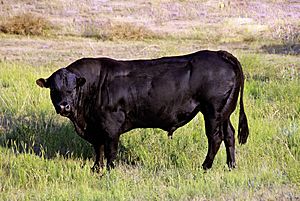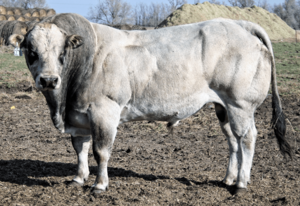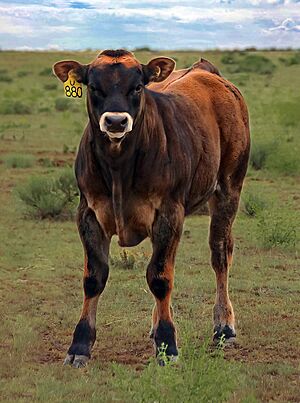North American Piedmontese facts for kids

National Champion MLF Unforgettable 911W
|
|
| Other names | Fullblood Piedmontese, and Naturalean Homozygous |
|---|---|
| Country of origin | North America |
| Distribution | Canada, United States |
| Standard | [1] |
| Use |
|
| Traits | |
| Weight |
|
| Height |
|
| Skin color | Fullblood are black Naturalean are black or reddish |
| Coat | Fullblood are gray, some black hairs on head and spots over body Naturalean are solid black, or solid red |
| Horn status | Fullblood are horned Naturalean may be polled |
|
|
North American Piedmontese cattle are a special type of beef cattle. They come from a group of purebred Italian Piedmontese cattle first brought to North America. These cattle are known for a unique, natural gene called the myostatin gene.
This gene helps them grow a lot of muscle. It's like a "muscle-building" gene. Because of this, Piedmontese cattle have what's called "double-muscling." This means they have more muscle, less fat, and their meat is very tender.
Purebred Piedmontese cattle have two copies of this special gene. Scientists can check for this gene using DNA testing. The North American Piedmontese Association (NAPA) is the first group to require this gene for registering these animals.
Contents
How North American Piedmontese Cattle Developed
North American Piedmontese cattle started from Italian Piedmontese cattle. These animals originally came from the Piedmont region in northwest Italy. In Italy, these cattle are used for two things: their rich milk makes special cheese, and their meat is sold as a high-quality product.
People think these cattle might be related to ancient Aurochs (a type of wild ox) and Pakistan Zebu cattle. The first records of breeding Piedmontese cattle go back to the late 1800s.
In 1979, a group in Saskatchewan, Canada worked hard to bring the first Piedmontese cattle to North America. It was difficult because the Italian Association didn't want to sell their purebred animals. Also, strict health rules made it tough.
Finally, in the fall of 1979, five Piedmontese cattle arrived in Canada. This took five years of effort and cost a lot of money. The next year, more Italian Piedmontese cattle came to Canada. Soon after, some arrived in the United States.
From these first animals, the North American Piedmontese breed began. Groups like the Canadian Piedmontese Association (CPA) and the Piedmontese Association of the United States (PAUS) were formed to help manage the breed. Today, there are many different family lines of these cattle available for farmers in North America.
Special Genes and Crossbreeding
Just like their Italian relatives, North American Piedmontese cattle have a special myostatin gene. This gene causes their muscles to grow very large, which is why they are called "double-muscled."
Studies show that even half-Piedmontese calves (when one parent is Piedmontese and the other is a different breed) are born easily. They also have good survival rates, similar to other common beef breeds.
These cattle are very good at turning their food into lean muscle. They produce more of the best meat cuts. On average, they have about 20% more muscle and less bone and fat than regular beef cattle. Their meat is also very tender because it has less tough tissue.
How Common Are They in the United States?
There are many cattle in the United States, but Piedmontese cattle are quite rare. Less than half of one percent of all beef cattle in the U.S. are Piedmontese or have Piedmontese blood. In 2014, there were only about 2,900 purebred Piedmontese cattle registered in the United States.
In the United States, the USDA helps regulate Piedmontese beef. This means that groups selling Piedmontese beef must follow rules for labeling and showing how healthy the meat is.
What North American Piedmontese Cattle Look Like
Fullblood Piedmontese males are gray-white. They have a lot of black hair on their heads, especially around their eyes, neck, and shoulders. They also have black on their lower legs. Sometimes, they have dark spots on their hind legs or sides.
The cows are mostly white, with some gray or light red colors. Calves are born a light fawn color, which changes to gray-white as they get older. Fullbloods naturally have horns. They also have black skin on their nose, eyelids, ears, tongue, tail tip, and other areas.
Naturalean Piedmontese cattle, which can be a mix of breeds, can be solid black or solid red. They have black or reddish skin in the same areas as fullbloods. They might have horns or be naturally without horns (polled). They can have two copies of the myostatin gene (homozygous) or one copy (heterozygous).
Farmers often cross Fullblood or Naturalean bulls with other beef breeds like Black Angus or Hereford cattle. This is because the mixed calves have many benefits. Their meat has more protein and less saturated fat, is more tender, and gives about 7% more usable meat. Also, cows have fewer problems giving birth to these mixed calves.
North American Piedmontese Association (NAPA)
The North American Piedmontese Association (NAPA) was started in September 2000. It is the official group that registers North American Piedmontese cattle. NAPA is a non-profit organization based in Washington, U.S.
It is the first cattle breed registry that requires animals to have the special Piedmontese myostatin gene to be registered. There are different ways to register animals with NAPA.
Only animals with two copies of the gene (homozygous) can be fully registered. These animals will pass on the gene to their offspring. They can be registered as "Fullblood" (if their family tree is known) or "Naturalean."
The Naturalean group is for Piedmontese cattle that are crossbred or don't have a complete family tree, even if they could be Fullblood. Before registering, all animals must have a DNA test to confirm they have at least one copy of the Piedmontese myostatin gene.
Animals with only one copy of the gene (heterozygous) are "recorded" but not fully registered. Animals with zero copies of the gene cannot be registered at all.
NAPA says that in the late 1990s, more genetic material (like embryos and semen) was imported. This means that today, farmers have many different bloodlines to choose from when raising Piedmontese cattle.



